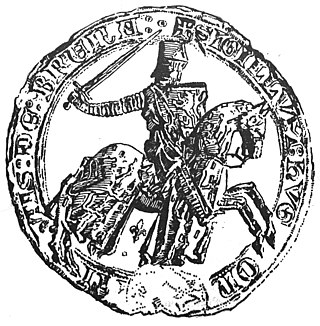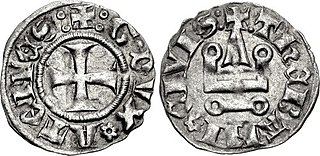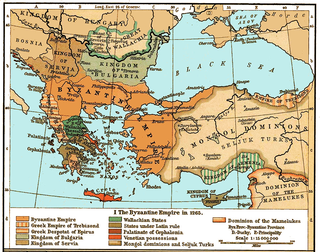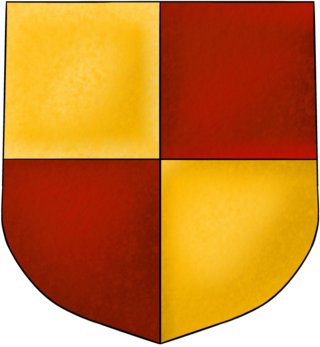
The Duchy of Athens was one of the Crusader states set up in Greece after the conquest of the Byzantine Empire during the Fourth Crusade as part of the process known as Frankokratia, encompassing the regions of Attica and Boeotia, and surviving until its conquest by the Ottoman Empire in the 15th century.

Walter V of Brienne was Duke of Athens from 1308 until his death. Being the only son of Hugh of Brienne and Isabella de la Roche, Walter was the heir to large estates in France, the Kingdom of Naples, and the Peloponnese. He was held in custody in the Sicilian castle of Augusta between 1287 and 1296 or 1297 to secure the payment of his father's ransom to the Aragonese admiral Roger of Lauria. When his father died fighting against Lauria in 1296, Walter inherited the County of Brienne in France, and the counties of Lecce and Conversano in southern Italy. He was released, but he was captured during a Neapolitan invasion of Sicily in 1299. His second captivity lasted until the Treaty of Caltabellotta in 1302.
During the late Middle Ages, the two cities of Argos and Nauplia formed a lordship within the Frankish-ruled Morea in southern Greece.

Hugh, Count of Brienne and Lecce was the second surviving son of Count Walter IV of Brienne and Marie de Lusignan of Cyprus.
Guy I de la Roche (1205–1263) was the Duke of Athens, the son and successor of the first duke Othon. After the conquest of Thebes, Othon gave half the city in lordship to Guy.
John I de la Roche succeeded his father, Guy I, as Duke of Athens in 1263. He was cultured and chivalrous, spoke fluent Greek, and read Herodotus.

Guy II de la Roche, also known as Guyot or Guidotto, was the Duke of Athens from 1287, the last duke of his family. He succeeded as a minor on the death of his father, William I, at a time when the duchy of Athens had exceeded the Principality of Achaea in wealth, power, and importance.
William I de la Roche succeeded his brother, John I, as Duke of Athens in 1280. He was the son of Guy I de la Roche.

Martino Zaccaria was the Lord of Chios from 1314 to 1329, ruler of several other Aegean islands, and baron of Veligosti–Damala and Chalandritsa in the Principality of Achaea. He distinguished himself in the fight against Turkish corsairs in the Aegean Sea, and received the title of "King and Despot of Asia Minor" from the titular Latin Emperor, Philip II. He was deposed from his rule of Chios by a Byzantine expedition in 1329, and imprisoned in Constantinople until 1337. Martino then returned to Italy, where he was named the Genoese ambassador to the Holy See. In 1343 he was named commander of the Papal squadron in the Smyrniote crusade against Umur Bey, ruler of the Emirate of Aydin, and participated in the storming of Smyrna in October 1344. He was killed, along with several other of the crusade's leaders, in a Turkish attack on 17 January 1345.

The War of the Euboeote Succession was fought in 1256–1258 between the Prince of Achaea, William of Villehardouin, and a broad coalition of other rulers from throughout Frankish Greece who felt threatened by William's aspirations. The war was sparked by Villehardouin's intervention in a succession dispute over the northern third of the island of Euboea, which was resisted by the local Lombard barons with the aid of the Republic of Venice. The Lord of Athens and Thebes, Guy I de la Roche, also entered the war against William, along with other barons of Central Greece. Their defeat at the Battle of Karydi in May/June 1258 effectively brought the war to an end in an Achaean victory, although a definite peace treaty was not concluded until 1262.
Jacqueline de la Roche, was sovereign baroness of Veligosti and Damala in 1308–1329, from 1311 in co-regency with her spouse.

Boniface of Verona was a Lombard Crusader lord in Frankish Greece during the late 13th and early 14th century. A third son from a junior branch of his family, he sold his castle to equip himself as a knight, became a protégé of Guy II de la Roche, Duke of Athens, expelled the Byzantines from Euboea in 1296, and advanced to become one of the most powerful lords of Frankish Greece. Following Guy II's death, he served as regent for the Duchy of Athens in 1308–09, and was captured by the Catalan Company in the Battle of Halmyros in March 1311. The Catalans held Boniface in high regard, and offered to make him their leader. Boniface refused, but retained close relations with them, sharing their hostility towards the Republic of Venice and its own interests in Euboea. Boniface died in late 1317 or early 1318, leaving his son-in-law, the Catalan vicar-general Alfonso Fadrique, as the heir of his domains.
Eschive d'Ibelin (1253–1312) was suo jure Lady of Beirut in 1282–1312. She was the daughter of John II of Beirut, lord of Beirut, and of Alice de la Roche, and a member of the influential Ibelin family.

The Zaccaria family was an ancient and noble Genoese dynasty that had great importance in the development and consolidation of the Republic of Genoa in the thirteenth century and in the following period. The Zaccarias were characterized by, according to scholarly handwritten documents of the time, having broad intelligence and their effective way of maintaining political power through manipulation.

Alice de la Roche, Lady of Beirut, Regent of Beirut was the wife of John II, Lord of Beirut in the Kingdom of Jerusalem. She was a daughter of Guy I, Lord of Athens. Alice is sometimes referred to as Alice of Athens. Alice was regent of Beirut for her daughter, Lady Isabella, while Isabella was the queen consort of Cyprus.

Isabella de la Roche was a daughter of Guy I de la Roche. She was married twice, firstly to Geoffrey of Briel, Lord of Karytaina and then secondly to Hugh, Count of Brienne, having children only with her second husband.
Guy (II) of Dramelay was the third Baron of Chalandritsa in the Principality of Achaea in Frankish Greece, and also bailli of the Principality in 1282–85.

The Barony of Veligosti or Veligosti–Damala was a medieval Frankish fiefdom of the Principality of Achaea, originally centred on Veligosti in southern Arcadia, but also came to include the area of Damala in the Argolid when it came under a cadet branch of the de la Roche family in the 1250s. After Veligosti was lost to the Byzantines towards 1300, the name was retained even though the barony was reduced to Damala.
William de la Roche was a Baron of Veligosti and Damala in the Principality of Achaea, and a relative of the ruling Dukes of Athens of the de la Roche family.
Helena Angelina Komnene was a daughter of the Greek sebastokrator John I Doukas, ruler of Thessaly in ca. 1268–1289, and a Greek princess of Aromanian origin, known only by her monastic name, Hypomone.










